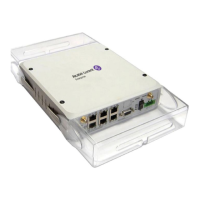Event and Accounting Logs
7705 SAR OS System Management Guide 289
The trap-target command is used to add or remove a trap receiver from an snmp-trap-group. The
operational parameters specified in the command include:
• the IP address of the trap receiver
• the UDP port used to send the SNMP trap
• SNMP version
• SNMP community name for SNMPv1 and SNMPv2c receivers
• security name and level for SNMPv3 trap receivers
A single snmp-trap-group log-id can have multiple trap receivers. Each trap receiver can have
different operational parameters.
An address can be configured as a trap receiver more than once as long as a different port is used for
each instance.
To prevent resource limitations, only configure a maximum of 10 trap receivers.
The no form of the command removes the SNMP trap receiver from the SNMP trap group.
Default No SNMP trap targets are defined.
Parameters name — specifies the name of the trap target, up to 28 characters in length
ip-address — the IP address of the trap receiver. Only one IP address destination can be specified
per trap destination group.
Values ipv4-address a.b.c.d (host bits must be 0)
ipv6-address x:x:x:x:x:x:x:x (eight 16-bit pieces)
x:x:x:x:x:x:d.d.d.d
x: [0 to FFFF]H
d: [0 to 255]D
port — the destination UDP port used for sending traps to the destination, expressed as a decimal
integer. Only one port can be specified per trap-target statement. If multiple traps need to be
issued to the same address, multiple ports must be configured.
Values 1 to 65535
Default 162
snmpv1 | snmpv2c | snmpv3 — specifies the SNMP version format to use for traps sent to the
trap receiver
Note: If the same trap-target name port port parameter value is specified in more than one
SNMP trap group, each trap destination should be configured with a different notify-
community value. This allows a trap receiving an application, such as NMS, to reconcile a
separate event sequence number stream for each 7705 SAR event log when multiple event
logs are directed to the same IP address and port destination.

